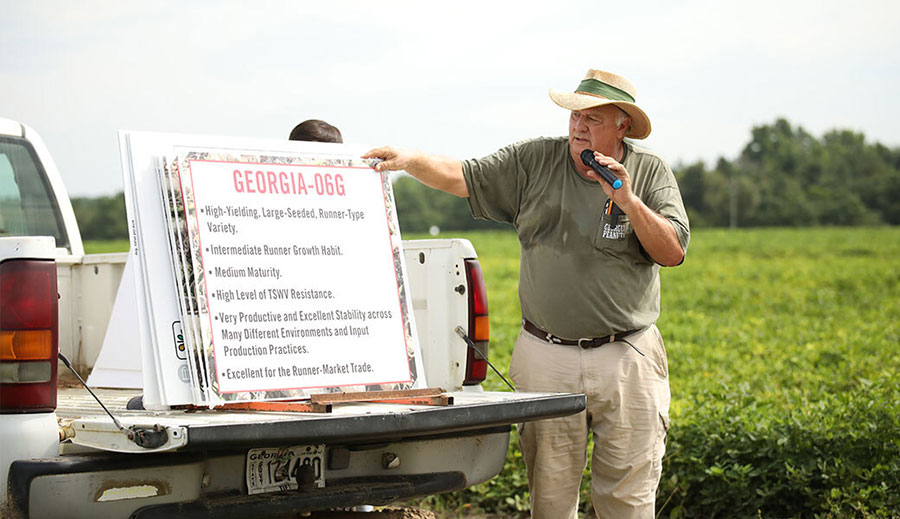Due to last year’s record-breaking peanut harvest and the current surplus supply of peanuts, Georgia peanut farmers will likely decrease the number of acres they plant this year.
Economists are hoping international demand for peanuts and rising domestic demand for peanut products will help to absorb some of the record number of nuts in the “peanut pipeline” and stabilize prices.
Falling peanut prices, rising corn prices
Farmers are expected to drastically reduce the number of the peanut acres they plant this year because of high prices projected for competing row crops, like cotton, corn and soybeans.
“The peanut outlook for 2013 will be a reverse of 2011,” said Nathan Smith, a UGA Cooperative Extension crop economist. “Instead of concern about planting too many acres, the concern could be planting too few acres.”
High peanut prices, driven by a peanut shortfall in 2011, led farmers to plant a near record number of acres in peanuts in 2012. The large amount of planted acres paired with record yields per acre have forced peanut prices down to 2009-10 levels. Those prices will be slow to rise as the peanut surplus is worked down up, Smith said.
“Production was expected to increase due to the large increase in acreage in 2012, but yields were well above expectations, leading to a great many more peanuts,” Smith said.
Smith predicts the total peanut supply, when tallied for the 2012 harvest, will jump from 1.84 million to 3.37 million tons.
Contracts offered to growers in 2013 will take into account current peanut supplies and where cotton and corn prices are headed, Smith said. Soybeans could be a player, too, in 2013. The price offered to growers will not exceed returns of cotton, corn and soybeans, he said. So the stage is set for lower peanut prices in 2013.
“The best case scenario would be if cotton prices all of sudden took off, which there is a low probability of that happening,” Smith said. “The other scenario that would raise prices would be low acres coupled with production problems.”
A perfect year for peanuts, in Georgia and across the U.S.
Georgia’s 2012 average yield was 4,550 pounds per acre. This surpassed 2011’s yield of 3,625 pounds per acre. Georgia growers planted 735,000 acres in 2012, up 55 percent from 2011.
“Total 2012 U.S. peanut production is pegged at 3.37 million tons, an 84 percent increase and better than the previous record of 2.58 million tons set in 2008,” he said. “The (National Agricultural Statistics Service) estimate for the U.S. average yield is also a record at 4,192 pounds per acre. This breaks the 2008 record yield of 3,426 pounds per acre.”
U.S. growers increased planted acres by 43 percent to 1.64 million acres last year. Smith predicts this year’s acreage will move to between 1.1 and 1.2 million acres.
“Assuming a 24 percent decrease in planted acres to 1.25 million and a normal abandonment rate, growers would produce a 2.2 million ton crop at 3,520 pound expected yield,” he said.
Domestic and international peanut demand rising
“Peanut and peanut butter prices at the retail level rose to slow demand and as a result domestic consumption dropped 1.2 percent (in 2012). The actual loss in consumption is higher because of lost growth in domestic use,” Smith said.
This year’s expected high feed prices will keep meat prices high and cause many households to turn to peanut butter as a good substitute of protein, he said.
“Growth in domestic food use should rebound,” Smith said. “USDA currently projects a 7 percent rate of increase, but it could be closer to 9 percent or more by the summer.”
The domestic demand for peanut oil is much greater than the supply. The number of peanuts crushed for oil will rise in 2013 mainly due to the record large 2012 production, Smith said.
He forecasts 370,000 tons of peanut crush, a by-product of peanut production where non-edible grades are crushed to produce peanut oil and meal. Peanut seed and residual are also projected to increase nearly 25 percent to 300,000 tons.
“Acreage will decrease but residual use will more than offset the loss in seed supply,” he said.
Total exports are expected to jump to 500,000 tons, Smith said, and will be instrumental in decreasing the surplus. Exports are projected to have the largest increase — 85 percent over last year.
Adding up the major categories, USDA projects the total consumption of peanuts for the 2012-13 marketing year to be 2.59 million tons. If realized this would be a total increase of 7 percent.
Shelling plants should be busy shelling the 2012 crop and will not be finished at the end of 2013. The peak of peanut harvest is typically mid-October.
“The excellent yields of 2012 will be fresh on farmers’ minds, but they should not assume a repeat will occur in 2013,” Smith said.
For more information on the peanut crop in Georgia, go to www.caes.uga.edu/commodities/fieldcrops/peanuts/.

.jpg)
.jpg)
.jpg)





